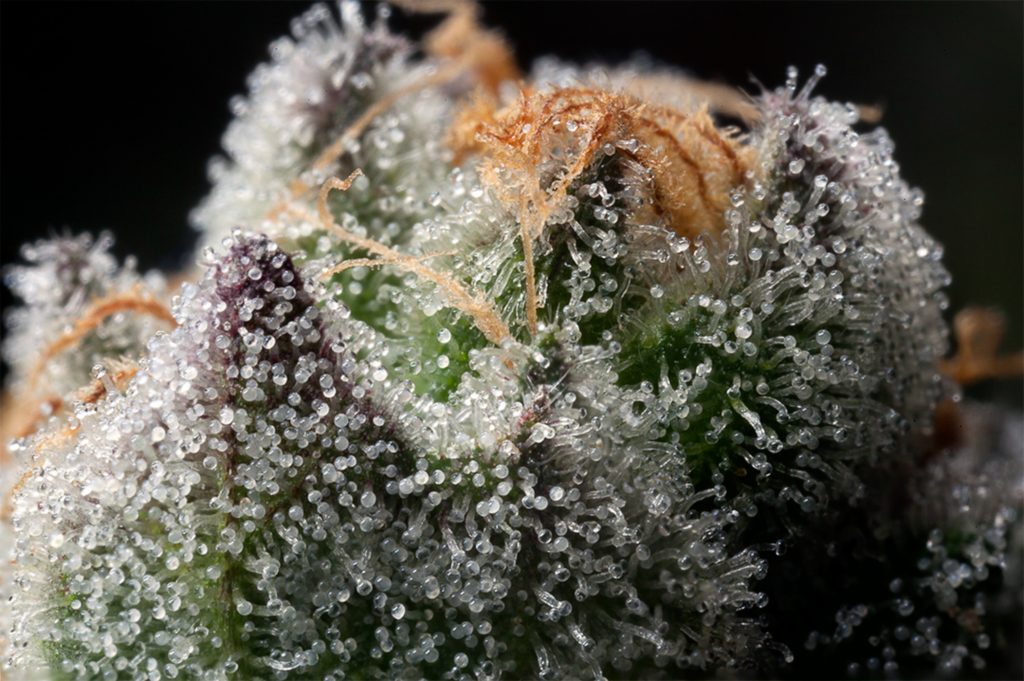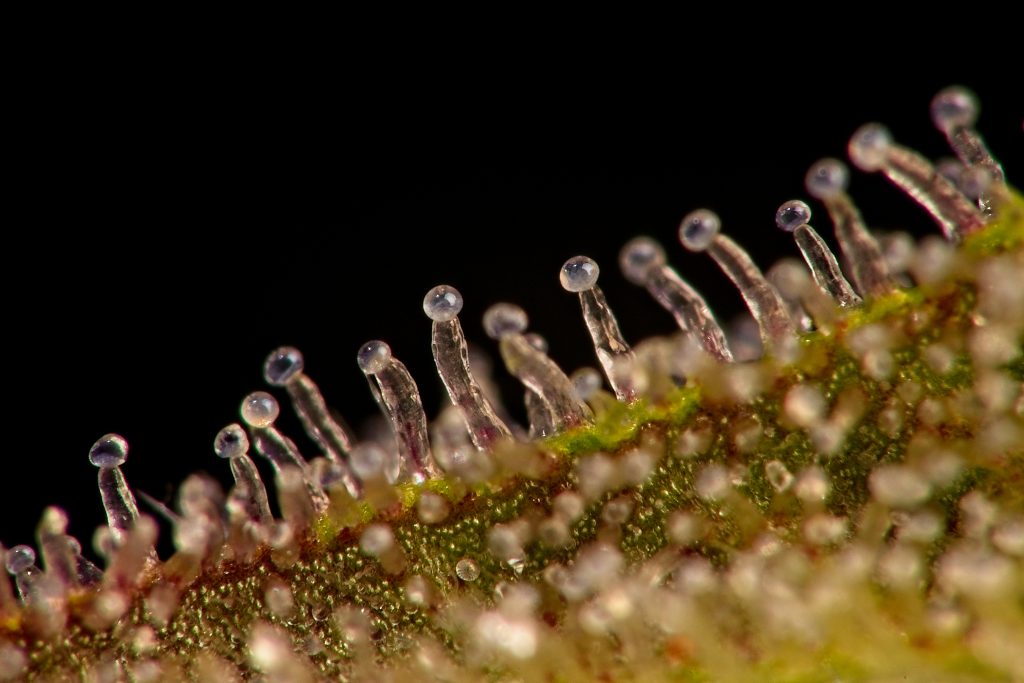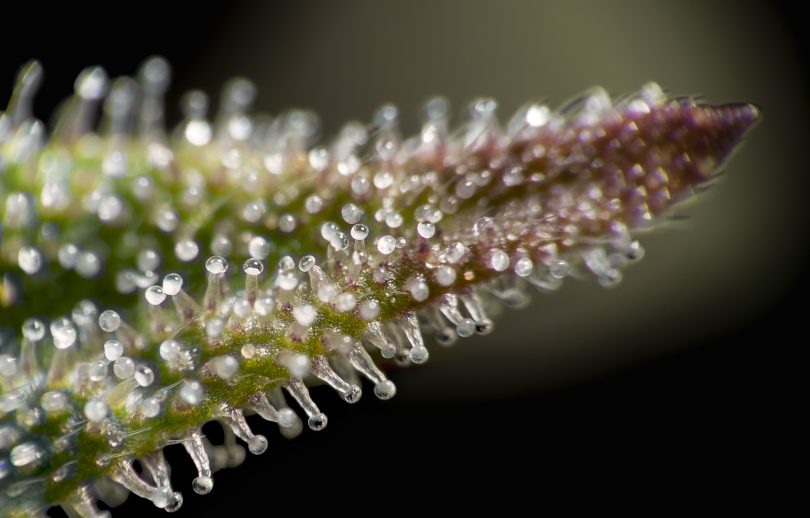When determining the quality of cannabis flowers, one of the visual characteristics you’ll be looking for are those lovely crystals that coat the outside of high-quality nugs – formally known as trichomes.
The most important compounds in the cannabis plant – the cannabinoids that produce all the desired effects, along with the terpenes that boost said effects and give us the aromas and flavors we enjoy so very much – all start out as trichomes. So, the reason we love weed so much is almost entirely attributable to these trichomes, but how much do we really know about them?
The cannabis plant is so interesting and complex, and we’re learning more about it every day. To stay current on everything important happening in the industry, subscribe to the THC Weekly Newsletter. Also, it’ll get you premium access to deals on cannabis flowers, vapes, edibles, and much more! We’ve also got standout offers on cannabinoids, like HHC-O, Delta 8, Delta 9 THC, Delta-10 THC, THCO, THCV, THCP & HHC, which won’t kill your bank account. Head over to our “Best-of” lists to get these deals, and remember to enjoy responsibly!
Different types of cannabis trichomes
It can be hard to tell with the naked eye, but trichomes actually come in many different shapes and sizes. They can be unicellular or multicellular, as well as glandular or non-glandular. Glandular consists of a stalk ending in a glandular head, and non-glandular has elongated tapering structures at the end instead of a larger gland.
unicellular or multicellular and are either glandular, consisting of a stalk terminating in a glandular head, or nonglandular, consisting of elongated tapering structures.
Three types of trichomes are seen most frequently on the cannabis plant: Bulbous trichomes, capitate sessile trichomes, and capitate stalked trichomes. The smallest are bulbous trichomes, which are roughly 10-15 micrometers. Despite being found on the entire surface of the plant, they are still the least abundant trichome found on cannabis. The next size up are capitate sessile trichomes. These are slightly larger, slightly more prominent, and are comprised of two complete parts, a head and stalk.
The largest and most plentiful are capitate stalked trichomes. They range in size between 50-100 micrometers wide and these are the ones that you can see without any type of visual aid. They’re made of a stalk containing epidermal and hypodermic cells, that build up to a basal cell that is attached to the base of a large glandular head. The entire structure is held together by a waxy cuticle layer, acting as a sort of glue/cement for the trichome.

Within the capitate stalked trichomes is where all the cannabinoid and terpenoid magic happens, as these trichomes are responsible for the synthesis of all the fun compounds. Because of their size and abundance, they produce the highest concentration of essential oils. So, in other words, the more capitate stalked trichomes you have, the more fire your weed will be.
How are they created?
When cannabis plants move into their blooming stage, that’s when the trichomes begin to form. Trichomes develop along the outer surface of every exposed part of the plant, so basically everything except the roots and some sections of the stems. From there, they begin to transport vacuoles and plastids from their stalk into the gland head.
The cells within the gland head of the trichome will then begin to metabolize, forming precursor chemicals to what will eventually become cannabinoids. Plants containing high concentrations of trichomes usually produce a large number of cannabinoids and terpenes as well, but that’s not always the case. Both genetics and the growing environment have a significant impact on the development of trichomes and the rate at which they convert to cannabinoids and terpenes.
According to Patrick Bennett from Leafly, “Variables such as UV light greatly affect cannabinoid and terpene synthesis within the trichome head. Typically, plants that receive a broader spectrum of light will produce higher concentrations of cannabinoids, though in many cases these reactions will be strain-specific.”
The lifecycle of a cannabis trichome
The life of a trichome is incredibly similar to that of the cannabis plant itself, in the sense that they age at the same rate, so trichomes are a very accurate indicator of plant maturation. Throughout the lifecycle of the trichome, the opacity changes from almost translucent in its early stages, to a misty white, and then turning a darker, amber hue towards the end. This can vary based on the strain, but regardless, trichome coloration is the go-to standard for determining whether your buds are ready or not.
Once the trichome has reached full maturation, it’s time to harvest. Shortly after this point the trichomes will begin to degrade and the flowers will lose their potency and flavor. During handling, you will have to be very careful not to damage the trichomes, as they are sensitive to a number of different stimuli including physical contact, time, and exposure to heat, light and oxygen – to name a few.
There are numerous ways to extend the life of your cannabis trichomes such as careful handling, proper trimming, drying, and curing techniques, and correct storage. All this combined will help keep your flowers fresh for as long as possible, and that’s important regardless of what side of the production chain you’re on.
Plant protection
In cannabis, and all plants that produce them, trichomes serve as protection from insects and other animal, as well as a variety of environmental irritants. When female plants begin to produce flowers, they become vulnerable and just like animals, plants evolve and adapt over time, developing a range of mechanisms used for survival and protection.

Among these are trichomes. The strong aroma secreted by these trichomes is what attracts humans to cannabis. Other animals are deterred by the smell and it prevents them from eating the plant. The sticky/oiliness we discussed earlier, produced by the capitate stalked trichomes, serves as another defense mechanism that traps insects when they come in contact with plant.
That oil also aids in a sort of self-regulation, by helping prevent excessive water loss from the leaves, as well as protecting the plant from extreme humidity, keeping it at the correct moisture level. The different trichome layers also help shield it from other harsh environmental conditions, such as pollution and smoke from wildfires.
With certain plants, Tragia for instance, the trichomes can form into small, stinging hairs that break off the plant and irritate whatever animal comes in contact with it. There were cactus species in my yard when I lived in the desert with these tiny, thread-like needles, and this is the same exact defense tactic used by tarantulas, who will rub their hind legs together to scatter small hairs into the eyes of their predators.
What are the effects in humans?
This is a very loaded question because the exact benefits and effects depend on what combination of cannabinoids and terpenoids are synthesized by the trichomes. In general, both of these compounds have proven effective in managing a myriad of different health conditions and diseases.
From a medical standpoint, nearly every naturally-occurring cannabis compound serves a purpose and can be used therapeutically in the human body. The two most abundant cannabinoids, THC and CBD, are both highly beneficial plant medicines. Cannabidiol, or CBD, has no psychoactive properties and is utilized widely to treat anxiety, pain, neurological disorders, inflammation, and the list goes on. Tetrahydrocannabinol (THC) is the compound known for its intoxicating effects, but it’s also a powerhouse of medicinal goodness in its own right. THC is great for relieving pain, treating nausea, managing depression, and it is said to regenerate brain cells in elderly users, among many other benefits.
Recreationally, cannabis is considered a psychoactive substance. The high can range considerably, with some people feeling relaxed and at peace, while others get anxious and paranoid. Even within those confines, there are so many variations of the kind of high you will feel. Some strains make you feel lazy and chill, while others have you more energized, creative, and inquisitive. Again, it all boils down to the specific combination of cannabinoids and terpenes, which can be traced even further, to the plant trichomes.
The Endocannabinoid System
To understand why cannabinoids are so effective and capable of targeting such a varied range of conditions, you will need to have a base understanding of the Endocannabinoid System (ECS). The ECS is a network of receptors that can be found throughout the bodies of nearly all living creatures (minus insects, as far as we know currently). We naturally create cannabinoids in our bodies – called endocannabinoids – which bond to these receptors to regulate different processes in our bodies and maintain internal balance and harmony.
So far, researchers have been able to identify two separate endocannabinoids: 2-arachidonoylglycerol (2-AG) and anandamide (AEA), as well as two main receptors: CB1 and CB2. 2-AG is a full agonist of both the CB1 and CB2 receptors but it has a more direct association with the CB2 receptor. Because of this, 2-AG is thought to have a substantial influence over the immune system.

Anandamide – or AEA – also casually known as the “bliss molecule”, has a major impact on our state of homeostasis. AEA can help manage things such as appetite, sleep wake cycles, pain response, and then some. Our bodies continuously cycle through anandamide. It breaks down very easily, so it doesn’t stay in the body for long. However, our bodies create it on-demand to maintain homeostasis.
There is a condition referred to as ‘cannabinoid deficiency’, characterized by a body’s inability to produce endocannabinoids. Some experts theorize that many illnesses we suffer from, stem from this shortage of endocannabinoids.
Final Thoughts
To say that trichomes are an important part of the cannabis plant would be a monumental understatement. Not only do they act as a defense mechanism for the plant – protecting it from pests and environmental pathogens; but trichomes are also the reason cannabis has so many qualities that are beneficial to us, both medicinally and recreationally.
Hello and welcome! You’ve made it to CBDtesters.co/Cannadelics.com, the #1 web spot for the most comprehensive independent news coverage of the cannabis and psychedelics industries. Join us whenever possible to stay in-the-loop on the ever-changing landscape of cannabis and psychedelics, and subscribe to The THC Weekly Newsletter, so you’re always on top of what’s going on.
Disclaimer: Hi, I’m a researcher and writer. I’m not a doctor, lawyer, or businessperson. All information in my articles is sourced and referenced, and all opinions stated are mine. I am not giving anyone advice, and though I am more than happy to discuss topics, should someone have a further question or concern, they should seek guidance from a relevant professional.







